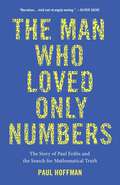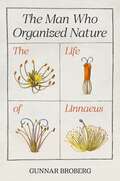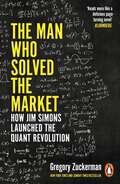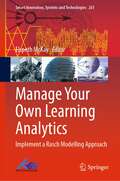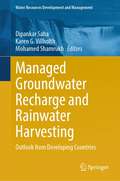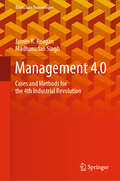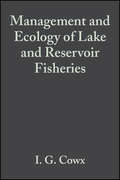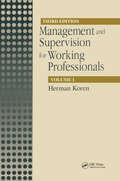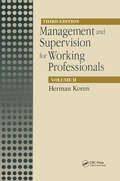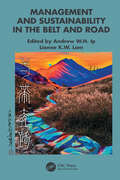- Table View
- List View
The Man Who Loved Only Numbers: The Story of Paul Erdos and the Search for Mathematical Truth
by Paul Hoffman"A funny, marvelously readable portrait of one of the most brilliant and eccentric men in history." --The Seattle Times Paul Erdos was an amazing and prolific mathematician whose life as a world-wandering numerical nomad was legendary. He published almost 1500 scholarly papers before his death in 1996, and he probably thought more about math problems than anyone in history. Like a traveling salesman offering his thoughts as wares, Erdos would show up on the doorstep of one mathematician or another and announce, "My brain is open." After working through a problem, he'd move on to the next place, the next solution. Hoffman's book, like Sylvia Nasar's biography of John Nash, A Beautiful Mind, reveals a genius's life that transcended the merely quirky. But Erdos's brand of madness was joyful, unlike Nash's despairing schizophrenia. Erdos never tried to dilute his obsessive passion for numbers with ordinary emotional interactions, thus avoiding hurting the people around him, as Nash did. Oliver Sacks writes of Erdos: "A mathematical genius of the first order, Paul Erdos was totally obsessed with his subject--he thought and wrote mathematics for nineteen hours a day until the day he died. He traveled constantly, living out of a plastic bag, and had no interest in food, sex, companionship, art--all that is usually indispensable to a human life."The Man Who Loved Only Numbers is easy to love, despite his strangeness. It's hard not to have affection for someone who referred to children as "epsilons," from the Greek letter used to represent small quantities in mathematics; a man whose epitaph for himself read, "Finally I am becoming stupider no more"; and whose only really necessary tool to do his work was a quiet and open mind. Hoffman, who followed and spoke with Erdos over the last 10 years of his life, introduces us to an undeniably odd, yet pure and joyful, man who loved numbers more than he loved God--whom he referred to as SF, for Supreme Fascist. He was often misunderstood, and he certainly annoyed people sometimes, but Paul Erdos is no doubt missed. --Therese Littleton
The Man Who Organized Nature: The Life of Linnaeus
by Professor Gunnar BrobergA new biography of Carl Linnaeus, offering a vivid portrait of Linnaeus’s life and workCarl Linnaeus (1707–1778), known as the father of modern biological taxonomy, formalized and popularized the system of binomial nomenclature used to classify plants and animals. Linnaeus himself classified thousands of species; the simple and immediately recognizable abbreviation “L” is used to mark classifications originally made by Linnaeus. This biography, by the leading authority on Linnaeus, offers a vivid portrait of Linnaeus’s life and work. Drawing on a wide range of previously unpublished sources—including diaries and personal correspondence—as well as new research, it presents revealing and original accounts of his family life, the political context in which he pursued his work, and his eccentric views on sexuality.The Man Who Organized Nature describes Linnaeus’s childhood in a landscape of striking natural beauty and how this influenced his later work. Linnaeus’s Lutheran pastor father, knowledgeable about plants and an enthusiastic gardener, helped foster an early interest in botany. The book examines the political connections that helped Linnaeus secure patronage for his work, and untangles his ideas about sexuality. These were not, as often assumed, an attempt to naturalize gender categories but more likely reflected the laissez-faire attitudes of the era. Linnaeus, like many other brilliant scientists, could be moody and egotistical; the book describes his human failings as well as his medical and scientific achievements. Written in an engaging and accessible style, The Man Who Organized Nature—one of the only biographies of Linnaeus to appear in English—provides new and fascinating insights into the life of one of history’s most consequential and enigmatic scientists.
The Man Who Organized Nature: The Life of Linnaeus
by Professor Gunnar BrobergA new biography of Carl Linnaeus, offering a vivid portrait of Linnaeus’s life and workCarl Linnaeus (1707–1778), known as the father of modern biological taxonomy, formalized and popularized the system of binomial nomenclature used to classify plants and animals. Linnaeus himself classified thousands of species; the simple and immediately recognizable abbreviation “L” is used to mark classifications originally made by Linnaeus. This biography, by the leading authority on Linnaeus, offers a vivid portrait of Linnaeus’s life and work. Drawing on a wide range of previously unpublished sources—including diaries and personal correspondence—as well as new research, it presents revealing and original accounts of his family life, the political context in which he pursued his work, and his eccentric views on sexuality.The Man Who Organized Nature describes Linnaeus’s childhood in a landscape of striking natural beauty and how this influenced his later work. Linnaeus’s Lutheran pastor father, knowledgeable about plants and an enthusiastic gardener, helped foster an early interest in botany. The book examines the political connections that helped Linnaeus secure patronage for his work, and untangles his ideas about sexuality. These were not, as often assumed, an attempt to naturalize gender categories but more likely reflected the laissez-faire attitudes of the era. Linnaeus, like many other brilliant scientists, could be moody and egotistical; the book describes his human failings as well as his medical and scientific achievements. Written in an engaging and accessible style, The Man Who Organized Nature—one of the only biographies of Linnaeus to appear in English—provides new and fascinating insights into the life of one of history’s most consequential and enigmatic scientists.
The Man Who Solved the Market: How Jim Simons Launched the Quant Revolution SHORTLISTED FOR THE FT & MCKINSEY BUSINESS BOOK OF THE YEAR AWARD 2019
by Gregory ZuckermanSHORTLISTED FOR THE FT AND MCKINSEY BUSINESS BOOK OF THE YEAR AWARD 2019'Reads more like a delicious page-turning novel...Put it on your holiday gift list for your favourite hedge-fund honcho' BloombergJim Simons is the greatest moneymaker in modern financial history. His record bests those of legendary investors, including Warren Buffett, George Soros and Ray Dalio. Yet Simons and his strategies are shrouded in mystery. The financial industry has long craved a look inside Simons's secretive hedge fund, Renaissance Technologies and veteran Wall Street Journal reporter Gregory Zuckerman delivers the goods. After a legendary career as a mathematician and a stint breaking Soviet codes, Simons set out to conquer financial markets with a radical approach. Simons hired physicists, mathematicians and computer scientists - most of whom knew little about finance - to amass piles of data and build algorithms hunting for the deeply hidden patterns in global markets. Experts scoffed, but Simons and his colleagues became some of the richest in the world, their strategy of creating mathematical models and crunching data embraced by almost every industry. As Renaissance became a major player in the financial world, its executives began exerting influence on other areas. Simons became a major force in scientific research, education and Democratic politics, funding Hilary Clinton's presidential campaign. While senior executive Robert Mercer is more responsible than anyone else for the Trump presidency, placing Steve Bannon in the campaign, funding Trump's victorious 2016 effort and backing alt-right publication Breitbart. Mercer also impacted the success of the Brexit campaign. For all his prescience, Simons failed to anticipate how Mercer's activity would impact his firm and the world. In this fast-paced narrative, Zuckerman examines how Simons launched a quantitative revolution on Wall Street, and reveals the impact that Simons, the quiet billionaire king of the quants, has had on worlds well beyond finance.
Manage Your Own Learning Analytics: Implement a Rasch Modelling Approach (Smart Innovation, Systems and Technologies #261)
by Elspeth McKayThis book sheds light on the practice of learning analytics, illuminating how others approach their data analysis. At the beginning of the book, a ‘prescriptive learning analytics planning model’ gives straightforward instructions for people to follow. This book is organized into ten chapters, falling into four topical sections: Managing Learning Analytics (overview, instructional systems design (ISD), instructional design, and planning data analysis); Cognitive Performance Measurement Practices (classical test theory (CTT), Rasch measurement theory (RMT), Item response theory(IRT), Rasch Modeling Tools (research design, setting methodology); and Case Studies (corporate training settings, healthcare industry, and educational courseware design). This book is an important reference for: educational research community and instructional systems designers; corporate training developers; postgraduate course developers; and doctoral students.
Managed Ecosystems and CO2: Case Studies, Processes, and Perspectives (Ecological Studies #187)
by R. J. Norby M. Stitt G. R. Hendrey H. Blum Josef Nösberger S. P. LongThis book provides an up-to-date review of the effects of increasing atmospheric carbon dioxide on agroecosystems, forests, and grasslands. It summarizes the main findings from 13 experiments with annual crops, permanent pastures and plantation forests at 11 sites throughout the world during the past ten years. The results significantly alter our perception of how rising CO2 will directly affect these managed ecosystems.
Managed Groundwater Recharge and Rainwater Harvesting: Outlook from Developing Countries (Water Resources Development and Management)
by Dipankar Saha Karen G. Villholth Mohamed ShamrukhThis book, through its 19 chapters, highlights success stories, research outputs and various government schemes and actions taken on groundwater recharge and rainwater harvesting in developing countries. The interventions are focused on resolving water crises through supply side interventions, improving water quality and addressing climate change impacts. The contributions from across the globe shows how these approaches have been successful in supplementing potable water supply, reducing the intensity of overexploitation of groundwater resources, better storm water management, intensifying treated grey water reuse, and improving groundwater quality and environmental flows. The chapters deal with a wide array of issues, from local-scale experimentation and management to government schemes adopted, community involvement, private sector engagement, addressing socio-economic issues and policy interventions. The book includes contributions made by researchers, government departments, civil societies, policymakers and practitioners from 15 Non-Aligned Movement (NAM) and other developing countries, namely Afghanistan, Bangladesh, Chile, Colombia, Egypt, Guatemala, India, Jordan, Morocco, Nigeria, Palestine, Qatar, South Africa, Sri Lanka and Tunisia. The book places before the readers, the strives being undertaken in the Global South to address the sustainability of water resources and climate change adaptation through traditional and innovative methods to groundwater recharge, water harvesting and storage.
Management 4.0: Cases and Methods for the 4th Industrial Revolution (Blockchain Technologies)
by James R. Reagan Madhusudan SinghThis book provides a comprehensive review of industry 4.0 and its applications, discussing the history of industry evaluation, including industry 1.0, 2.0, 3.0 and 4.0, and the future structure of industry evaluation. It also examines the effects and impact of various technologies in industry and presents new interdisciplinary business models based on advanced technologies with the help of use cases. Lastly, it highlights the benefits of technological implementation in industry using examples of real-world applications, providing a robust and reliable technological conceptual framework and roadmap for decision-makers in all areas of industry involved transformation.
Management and Ecology of Lake and Reservoir Fisheries
by Ian G. CowxIn this comprehensive edited book, international experts in fisheries management and ecology review and appraise the status of lake and reservoir fisheries, assessment of fisheries yields, trophic ecology, rehabilitation and conservation, including a special section on African lakes where so much information of huge relevance to fisheries managers is now available. Contributions from around the world. Carefully edited by internationally respected editor. Has been generated from acclaimed HIFI Symposium.
Management and Ecology of River Fisheries
by Ian G. CowxIn this edited work, international experts in fisheries management and ecology review and appraise the status of river fisheries, assessment methodology, constraints on development, issues and options regarding management and associated problems in both temperate and tropical countries. Recommendations are made to improve management and an attempt is made to provide guidelines for formulating policy, for planning methodology and for evaluating future activities. Assessment of fish community structure and dynamics. Factors constraining stock recruitment. Fish habitat requirements. Instream flow needs. Impact of water resource schemes. Rehabilitation of river fisheries. Enhancement of fish stocks. Exploitation of stocks. Management of migratory fish stocks. Conservation of endangered species. Integrated river management. Bioeconomic issues. Legislation. Multinational management of rivers. Case studies.
Management and Engineering Innovation: Foundations And Innovations (Management And Industrial Engineering Ser.)
by Carolina Machado J. Paulo DavimThis book discusses management and engineering innovation with a particular emphasis on human resource management (HRM) and production engineering. In an innovation context, the disciplines of management and engineering are linked to promote sustainable development, seeking cultural and geographical diversity in the studies of HRM and engineering, applications that can have a particular impact on organizational communications, change processes and work practices. This connection reflects the diversity of societal and infrastructural conditions. The authors mainly analyze research on important issues that transcend the boundaries of individual academic subjects and managerial functions. They take into account interdisciplinary scholarship and commentaries that challenge the paradigms and assumptions of individual disciplines or functions, which are based on conceptual and/or empirical literature. The book is designed to increase the knowledge and effectiveness of all those involved in management and engineering innovation whether in the profit or not-for-profit sectors, or in the public or private sectors. Contents 1. We the Engineers and Them the Managers, Teresa Carla Oliveira and Joao Fontes Da Costa. 2. Strategic Capabilities for Successful Engagement in Proactive CSR in Small and Medium Enterprises: A Resource-Based View Approach, Nuttaneeya (Ann) Torugsa and Wayne O’Donohue. 3. Innovative Management Development in the Automotive Supply Industry – A Preliminary Case Study for the Development of an Innovative Approach to Innovation Management, Frank E.P. Dievernich and Kim Oliver Tokarski. 4. Innovative Product Design and Development through Online Customization, M. Reza Abdi and Vipin Khanna. 5. Struggling for Survival and Success: Can Brazil’s Defense Industry Help Foster Innovation?, Alex Lôbo Carlos and Regina Maria de Oliveira Leite. 6. Knowledge Management Fostering Innovation: Balancing Practices and Enabling Contexts, Maria Joao Santos and Raky Wane. 7. Institutional Logics Promoting and Inhibiting Innovation, Teresa Carla Trigo Oliveira and Stuart Holland. 8. HRM in SMEs in Portugal: An Innovative Proposal of Characterization, Pedro Ribeiro Novo Melo and Carolina Machado. About the Authors Carolina Machado has been teaching Human Resource Management since 1989 at the School of Economics and Management, University of Minho, Portugal, becoming Associate Professor in 2004. Her research interests include the fields of Human Resource Management, International Human Resource Management, Training and Development, Management Change and Knowledge Management. J. Paulo Davim is Aggregate Professor in the Department of Mechanical Engineering at the University of Aveiro, Portugal. He has more than 25 years of teaching and research experience in production and mechanical engineering.
Management and Engineering Innovation
by Carolina Machado J. Paulo DavimThis book discusses management and engineering innovation with a particular emphasis on human resource management (HRM) and production engineering. In an innovation context, the disciplines of management and engineering are linked to promote sustainable development, seeking cultural and geographical diversity in the studies of HRM and engineering, applications that can have a particular impact on organizational communications, change processes and work practices. This connection reflects the diversity of societal and infrastructural conditions. The authors mainly analyze research on important issues that transcend the boundaries of individual academic subjects and managerial functions. They take into account interdisciplinary scholarship and commentaries that challenge the paradigms and assumptions of individual disciplines or functions, which are based on conceptual and/or empirical literature. The book is designed to increase the knowledge and effectiveness of all those involved in management and engineering innovation whether in the profit or not-for-profit sectors, or in the public or private sectors. Contents 1. We the Engineers and Them the Managers, Teresa Carla Oliveira and Joao Fontes Da Costa. 2. Strategic Capabilities for Successful Engagement in Proactive CSR in Small and Medium Enterprises: A Resource-Based View Approach, Nuttaneeya (Ann) Torugsa and Wayne O’Donohue. 3. Innovative Management Development in the Automotive Supply Industry – A Preliminary Case Study for the Development of an Innovative Approach to Innovation Management, Frank E.P. Dievernich and Kim Oliver Tokarski. 4. Innovative Product Design and Development through Online Customization, M. Reza Abdi and Vipin Khanna. 5. Struggling for Survival and Success: Can Brazil’s Defense Industry Help Foster Innovation?, Alex Lôbo Carlos and Regina Maria de Oliveira Leite. 6. Knowledge Management Fostering Innovation: Balancing Practices and Enabling Contexts, Maria Joao Santos and Raky Wane. 7. Institutional Logics Promoting and Inhibiting Innovation, Teresa Carla Trigo Oliveira and Stuart Holland. 8. HRM in SMEs in Portugal: An Innovative Proposal of Characterization, Pedro Ribeiro Novo Melo and Carolina Machado. About the Authors Carolina Machado has been teaching Human Resource Management since 1989 at the School of Economics and Management, University of Minho, Portugal, becoming Associate Professor in 2004. Her research interests include the fields of Human Resource Management, International Human Resource Management, Training and Development, Management Change and Knowledge Management. J. Paulo Davim is Aggregate Professor in the Department of Mechanical Engineering at the University of Aveiro, Portugal. He has more than 25 years of teaching and research experience in production and mechanical engineering.
Management and Engineering of Fire Safety and Loss Prevention: Onshore and offshore
by B. H. R. Group Bhr Group LtdThe papers presented deal with the general methods and techniques, from a range of disciplines, as they can be applied to specific engineering and fire safety situations. The circumstances described include a variety of large scale plant applications in the petrochemical industry. As such this book is a valuable reference for fire engineers, petroleum engineers and legislators working in today's multi-disciplinary design engineering team. These proceedings address five major areas of importance on and offshore: risk assessment, operations and operational safety, research, risk reduction and design safety, detection and control, and protective systems.
Management and Engineering of Fire Safety and Loss Prevention: Onshore and offshore
by Bhr Group LtdThe papers presented deal with the general methods and techniques, from a range of disciplines, as they can be applied to specific engineering and fire safety situations. The circumstances described include a variety of large scale plant applications in the petrochemical industry. As such this book is a valuable reference for fire engineers, petroleum engineers and legislators working in today's multi-disciplinary design engineering team. These proceedings address five major areas of importance on and offshore: risk assessment, operations and operational safety, research, risk reduction and design safety, detection and control, and protective systems.
Management and Intelligent Decision-Making in Complex Systems: An Optimization-Driven Approach
by Ameer Hamza Khan Xinwei Cao Shuai LiIn this book, the authors focus on three aspects related to the development of articulated agents: presenting an overview of high-level control algorithms for intelligent decision-making of articulated agents, experimental study of the properties of soft agents as the end-effector of articulated agents, and accurate management of low-level torque-control loop to accurately control the articulated agents. This book summarizes recent advances related to articulated agents. The motive behind the book is to trigger theoretical and practical research studies related to articulated agents.
Management and Supervision for Working Professionals, Third Edition, Volume I
by Herman KorenThe practical set of methods and tools contained in the two volumes of Management and Supervision for Working Professionals provides the reader with the knowledge and means to become an effective manager or supervisor. Volume I emphasizes organizational structure, planning, and leadership, while Volume II emphasizes communication, instruction, and daily management responsibilities such as performance ratings, unions, and health and safety.
Management and Supervision for Working Professionals, Third Edition, Volume I
by Herman KorenThe practical set of methods and tools contained in the two volumes of Management and Supervision for Working Professionals provides the reader with the knowledge and means to become an effective manager or supervisor. Volume I emphasizes organizational structure, planning, and leadership, while Volume II emphasizes communication, instruction, and daily management responsibilities such as performance ratings, unions, and health and safety.
Management and Supervision for Working Professionals, Third Edition, Volume II
by Herman KorenThe practical set of methods and tools contained in the two volumes of Management and Supervision for Working Professionals provides the reader with the knowledge and means to become an effective manager or supervisor. Volume I emphasizes organizational structure, planning, and leadership, while Volume II emphasizes communication, instruction, and daily management responsibilities such as performance ratings, unions, and health and safety.
Management and Supervision for Working Professionals, Third Edition, Volume II
by Herman KorenThe practical set of methods and tools contained in the two volumes of Management and Supervision for Working Professionals provides the reader with the knowledge and means to become an effective manager or supervisor. Volume I emphasizes organizational structure, planning, and leadership, while Volume II emphasizes communication, instruction, and daily management responsibilities such as performance ratings, unions, and health and safety.
Management and Supervisory Practices for Environmental Professionals: Two Volume Set
by Herman Koren Alma Mary AndersonBased on the lifelong experiences of two authors as supervisors and teachers, the Fourth Edition of this bestseller provides up-to-date information for newly promoted or management-aspiring professionals and engineers in the fields of environmental health, occupational health and safety, water and wastewater treatment, public health, and many others. The first volume explains, through nine sets of tools, the basic principles supervisors need to understand the structure of their organization, what leadership is, how to effectively plan and budget, how to manage other people, and best practices for achieving success in a management position. The second volume explains the advanced principles that supervisors need to understand the art of communications, resolving communications problems, and the supervisor/manager’s role in teaching, counseling, and managing employee performance and employee health and safety. In addition to those already practicing professionals in their fields, this book is an excellent resource for students interested in learning management skills prior to entering the workforce. Features of the Fourth Edition Helps to understand and utilize organizational structure to facilitate problem solving Offers a practical set of methods, tools, and techniques, all illustrated and easy to understand, for achieving leadership qualities Provides concise but essential discussion material for each topic, using the practical art of communications Includes thorough updates and many new case problems with answers provided Introduces self-testing questions for different situations and practical exercises utilizing an individual’s own work experience for answers
Management and Sustainability in the Belt and Road
by Lianne K. W. Lam Andrew W. H. IpChina’s Belt and Road Initiatives (BRI) is an ambitious infrastructure project conceived in 2013 by President Xi Jinping with development and investment initiatives stretching from Asia and Europe that reflect the original Silk Road with business networks through countries such as Afghanistan, Kazakhstan, Kyrgyzstan, Tajikistan, Turkmenistan, and Uzbekistan, as well as India and Pakistan, spanning a route of more than 4,000 miles and history that can be dated back more than 2,200 years. Given the background of China’s unique approach in fighting COVID-19, and against the backdrop of sluggish economic growth, innovation, and management, sustainable development of BRI will be the key and the driving force for the post-pandemic economic recovery of many countries, especially as BRI countries now account for nearly 30% of China’s foreign trade and 15% of outward direct investment. The vision to create a vast network of railways, energy pipelines, highways, and streamlined border crossings to expand the international use of Chinese currency and improve connectivity to China is good foresight and proved fortuitous when the COVID-19 pandemic came to plague the world, and amid the conflicts between the United States and China as well as the war between Russia and Ukraine. Since the inception of BRI, many books have been written to cover topics ranging from globalization to detailing how China’s business and politics are a major motivation for China’s overseas economic activities with case studies and practices, yet few of these books provide a structured approach to the sustainable management of BRI projects. This book is about how to manage the innovation, sustainability, and business necessary to make BRI work and how to handle the issues, problems, and crises that may arise in the process. Participants of BRI projects can take on many different roles, but ultimately, it is team effort and leadership that creates successful projects. Here, readers will find guidelines and insights to survive and prosper in a myriad of BRI opportunities and risks. Most important of all, this book provides a glimpse of different approaches for success in BRI projects, including sustainability, environmental issues, social and political aspects, technology, choice of industry, project management, education and training, governance, and many more.
Management and Sustainability in the Belt and Road
China’s Belt and Road Initiatives (BRI) is an ambitious infrastructure project conceived in 2013 by President Xi Jinping with development and investment initiatives stretching from Asia and Europe that reflect the original Silk Road with business networks through countries such as Afghanistan, Kazakhstan, Kyrgyzstan, Tajikistan, Turkmenistan, and Uzbekistan, as well as India and Pakistan, spanning a route of more than 4,000 miles and history that can be dated back more than 2,200 years. Given the background of China’s unique approach in fighting COVID-19, and against the backdrop of sluggish economic growth, innovation, and management, sustainable development of BRI will be the key and the driving force for the post-pandemic economic recovery of many countries, especially as BRI countries now account for nearly 30% of China’s foreign trade and 15% of outward direct investment. The vision to create a vast network of railways, energy pipelines, highways, and streamlined border crossings to expand the international use of Chinese currency and improve connectivity to China is good foresight and proved fortuitous when the COVID-19 pandemic came to plague the world, and amid the conflicts between the United States and China as well as the war between Russia and Ukraine. Since the inception of BRI, many books have been written to cover topics ranging from globalization to detailing how China’s business and politics are a major motivation for China’s overseas economic activities with case studies and practices, yet few of these books provide a structured approach to the sustainable management of BRI projects. This book is about how to manage the innovation, sustainability, and business necessary to make BRI work and how to handle the issues, problems, and crises that may arise in the process. Participants of BRI projects can take on many different roles, but ultimately, it is team effort and leadership that creates successful projects. Here, readers will find guidelines and insights to survive and prosper in a myriad of BRI opportunities and risks. Most important of all, this book provides a glimpse of different approaches for success in BRI projects, including sustainability, environmental issues, social and political aspects, technology, choice of industry, project management, education and training, governance, and many more.
Management and Sustainable Development of Coastal Zone Environments
by A. L. Ramanathan Prosun Bhattacharya Thorsten Dittmar B. Prasad B. NeupaneCoastal areas face increasing pressures from land use change, developmental activities, shoreline erosion, biodiversity losses and natural calamities. This volume addresses these issues facilitating the integrated analysis of the sustainability of coastal zones. The contributors have tried to focus their respective works on the problems that need urgent attention relevant to present day issues. Coastal Zone Management and its sustainability strategy should safeguard ecological security of the coastal areas, avoid pollution as well as exploitation of living and non living aquatic resources, protecting also the agrarian community and avian population and other floral and faunal breeding grounds. Articles have been selected on the basis of sound scientific findings hoping that it will help in developing meaningful regulations for future sustainable coastal management zone.
Management and Technological Challenges in the Digital Age (Manufacturing Design and Technology)
by Pedro Novo Melo Carolina MachadoBusinesses operate amid a digital age, and unsurprisingly, technology has engendered tools that now predominate all corners of the workplace. The ascendancy of new hardware and software poses new challenges for professionals in the field of management and human resources as corporations and companies routinely implement and incorporate digital software for goals such as improving worker productivity and tasks such as screening highly qualified candidates for vacancies. In the face of rapid change, professionals must investigate how the use of digital technology affects the culture of hiring processes, employee morale, company management, and corporate image. This book aims to promote research related to these new trends and open a new field within the areas of management and engineering. Through the course of nine chapters, contributors to Management and Technological Challenges in the Digital Age grapple with the theoretical and practical implications that technological usage carries across the range of small and large organizations in the world of business. Focuses on the latest research findings that are occurring in this field in different countries Shows how companies around the world are facing today's technological challenges Shares knowledge and insights on an international scale Keeps the readers and researchers informed about the latest developments in the field and forthcoming international studies Explains how the use of technology allows management to take a more strategic role in organizations This book affords a thorough engagement with the progresses and setbacks made through the enlistment of technological equipment and computerized procedures in the field of human resources and management while interrogating the future challenges of technology’s role.
Management and Technological Challenges in the Digital Age (Manufacturing Design and Technology)
by Crc PressBusinesses operate amid a digital age, and unsurprisingly, technology has engendered tools that now predominate all corners of the workplace. The ascendancy of new hardware and software poses new challenges for professionals in the field of management and human resources as corporations and companies routinely implement and incorporate digital software for goals such as improving worker productivity and tasks such as screening highly qualified candidates for vacancies. In the face of rapid change, professionals must investigate how the use of digital technology affects the culture of hiring processes, employee morale, company management, and corporate image. This book aims to promote research related to these new trends and open a new field within the areas of management and engineering. Through the course of nine chapters, contributors to Management and Technological Challenges in the Digital Age grapple with the theoretical and practical implications that technological usage carries across the range of small and large organizations in the world of business. Focuses on the latest research findings that are occurring in this field in different countries Shows how companies around the world are facing today's technological challenges Shares knowledge and insights on an international scale Keeps the readers and researchers informed about the latest developments in the field and forthcoming international studies Explains how the use of technology allows management to take a more strategic role in organizations This book affords a thorough engagement with the progresses and setbacks made through the enlistment of technological equipment and computerized procedures in the field of human resources and management while interrogating the future challenges of technology’s role.
